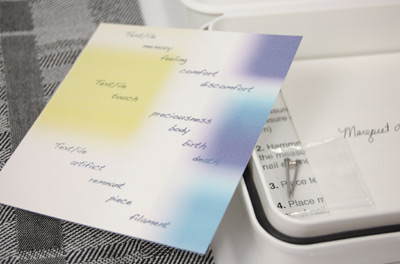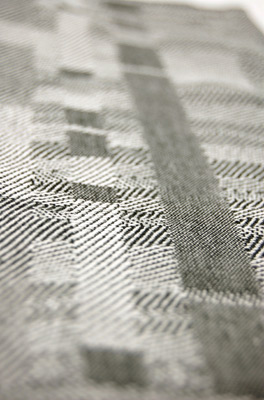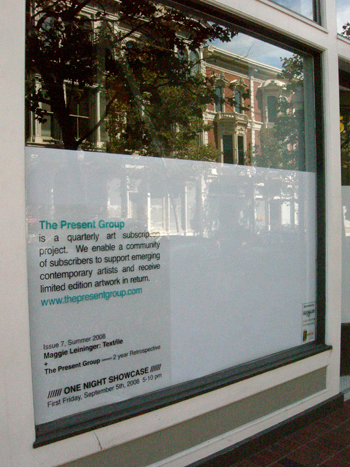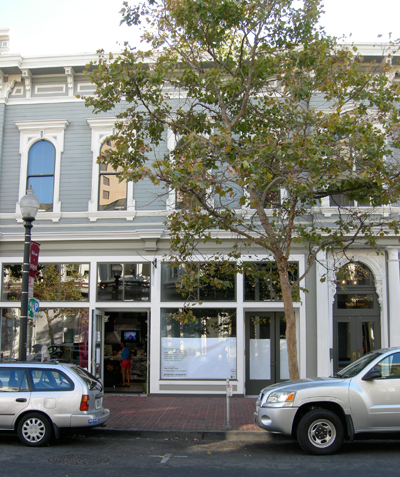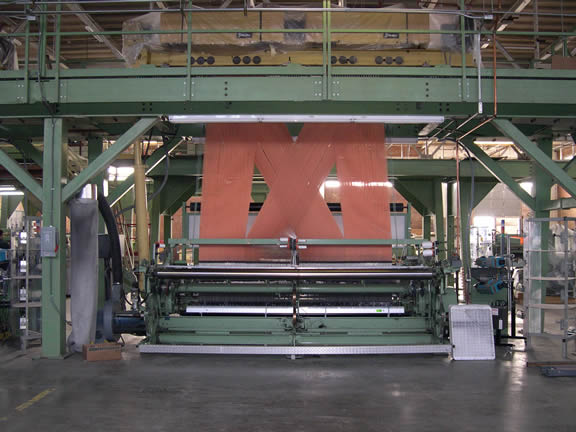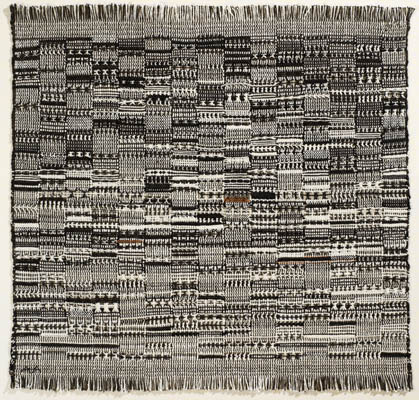“It’s a kind of microscopic herd mentality…Cells figure out which passages [in DNA] to pay attention to by observing signals from the cells around them: only with that local interaction can complex neighborhoods of cell types come into being.”
–Steven Johnson, Emergence
“It is safe, I suppose, to assume that today most if not all of us have had the experience of looking down from an airplane onto this earth. What we see is a free flow of forms intersected here and there by straight lines, rectangles, circles and evenly drawn curves; that is, by shapes of great regularity…[H]ere before us we can recognize the essence of designing, a visually comprehensible, simplified organization of forms that is distinct from nature’s secretive and complex working.”
–Anni Albers, “Designing As Visual Organization”
A white plastic box inscribed with a colorful legend, anonymously medical or scientific in origin, opens to reveal a woven textile, folded upon itself, black and white threads that merge into a shifting pattern of gray rectangles. Unrolled and displayed vertically, the swatch immediately brings to mind the reductive shapes and optical experimentation of Modernist abstraction. If pressed for a literal reference, I might say that the textile looks like nothing so much as the generically industrial, grainy landscapes of aerial photography: a cluster of buildings, parking lots, a straight road.
However, the framing–the ambiguously medical plastic, the charts on the sticker, with terms like “probes” and “polymorphism”–hints at a different meaning in the flat gray shapes. Because in fact Maggie Leininger’s “Text/ile” does have a literal reference, and it is in the basic informational structure of the human body. For this project, scientific diagrams of chromosomes–8 of the 23 found in human cells–have been reduced to grayscale patterns composed of black and white thread and woven on a Jacquard Loom into textiles remarkable in how they bring to mind not data but the abstract patterns of Modernist design.
Maggie Leininger works systematically on these multiple layers of representation and reference, finding within the building blocks of life hints of other forms, of city blocks and aerial topographies. Here the forms of Modernism, once so carefully divorced from literal reference, are found to contain the elemental information that guides the functioning of human cells. In her previous works the connection between microscopic and macroscopic forms was even more overt. In “Specimen” (2004) aluminum cylinders–resembling specimen jars or assay plates–are stitched with colorful patterns that could be cells seen under the microscope, could be colonies of bacteria on a petri dish, or could equally be mineral deposits in an estuary viewed from an airplane window.
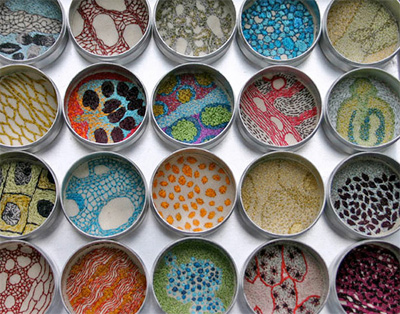
Specimen by Maggie Leininger (2004)
In science the curious repetition of forms across multiple scales is a familiar idea. The term “self-similarity” describes a form that can be broken down into infinitely smaller parts, each a tiny likeness of the first. Self-similarity is behind the recursively complex structures of fractal geometry, perhaps familiar from its brief popularity in the early years of digital art. In nature self-similarity is more approximate, but is clearly present in forms like Romanesco broccoli or the way a tree trunk branches off into branches into branches…. Self-similarity has a central place in Complexity theory, which attempts to describe the way in which infinitely complex systems can arise from the interaction of a few simple rules or processes. This, too, is an idea obliquely referenced in Leininger’s work, concerned as she is with the simple structures that combine to form organisms and superorganisms. Complexity displays across many scales, from micro to macro: from the way that cells form an organism to the way that a few settlements form neighborhoods, which in turn weave themselves into a city. Complexity theory and the principle of Emergence seek to describe the ways in which these complex structures come into being without organized planning, without top-down interference from a central authority. Leininger has a stated interest in the systems behind urban structures, in neighborhoods bounded by the “invisible lines known only by the inhabitants,” and so it makes sense that she would find hints of the automatic, organic assembling of cells in a city seen from a great height.
And so the curious slash in the title, “Text/ile”, deliberately breaking out the word “text”, underscores perhaps how meaning is a similar system, how it is woven by the combination of words, how words themselves can be broken down into phonemes, into letters, themselves the building blocks of communication. Like cells or a city, language is a complex system built from the interactions of simple rules. The three poems meant to accompany the piece hint at a personal narrative not necessarily present in a representation of human chromosomes, with concepts like ‘artifact’, ‘birth’, ‘death’, ‘memory’ acting as ciphers to suggest whatever simple concept, whatever hidden connotations, they hold for each of us. Yet DNA is, in a sense, an artifact, a legacy woven through generations of organisms, and the Human Genome Project treats DNA almost as a language, as a code that can be cracked.
Ultimately with “Text/ile” these references are shadowed by the overwhelming allusion to Modernist design in the woven swatches, and here perhaps is where the most interesting connective thread peeks out from the weave. There is an obvious aesthetic precedent in the work of Anni Albers, textile artist and member of the Bauhaus, a German craft and design school highly influential in popularizing Modernist design philosophy in the first quarter of the twentieth century. Albers, equally fascinated by language, wrote extensively on design, and, along with Bauhaus colleagues like Walter Gropius and her husband, Josef Albers, helped to publicize a modern aesthetic that focused on radically reduced shapes, an emphasis on rationality and the harmony of form and function. Modernism as a movement affirmed mankind’s relentless march into the future, aided by the constant progress and improvements allowed by science and technology.
The vision afforded to the Modernist subject is rational, clinical and–aided by advancements in optics like the camera, the microscope–Modernist vision is unparalleled in its powers of observation, its ability to see the world across a range of scales, from deep into the cell to deep into the cosmos. The viewer of “Text/ile”, armed with the technological heir to this Modernist eye, takes what writer and complexity theorist Steven Johnson calls “the long zoom”: a perspective that shifts fluidly from the macro to the micro. In fact, it is a sort of “god’s eye view” that forms the connective thread between all of Leininger’s works, the way in which whatever is represented is represented as from above, whether it is through the lens of a microscope or a spy satellite. In the forms that comprise her work the viewer is given the benefit of a distance that makes vague the distinctions between the very small and the very large in order to emphasize their visual similarity at all scales. Modernism grants the eye the power to reduce the world into its constituent parts, to arrange even our bodies into a text that can be read and understood. Where once pictorial tapestries might have advertised the power and riches of the nobles, Leininger’s textile works seem to affirm the optical power of modernity, our ability through science to apprehend the world from the microscopic elements of the human body to the daily actions and interactions that form the structure and life of a city.

Ancient Writing by Anni Albers (1936)
Nature, certainly no less complex than in Anni Alber’s time, but perhaps a great deal less “secretive”, has in Leininger’s work arrayed itself like a text for human viewing. And humans are furnished with a power of vision once reserved for gods. Seen from above, the distinctions between the design of cities and the organic forms of nature are much less pronounced than when Albers wrote “Designing as Visual Organization”, woven as they are from simple patterns and rules, iterated outward into works of infinite complexity.
.
.
.
.
Andrew Venell is a designer, hypertext author and multimedia artist whose works explore issues of urbanism, surveillance, commerce and mass communication.
